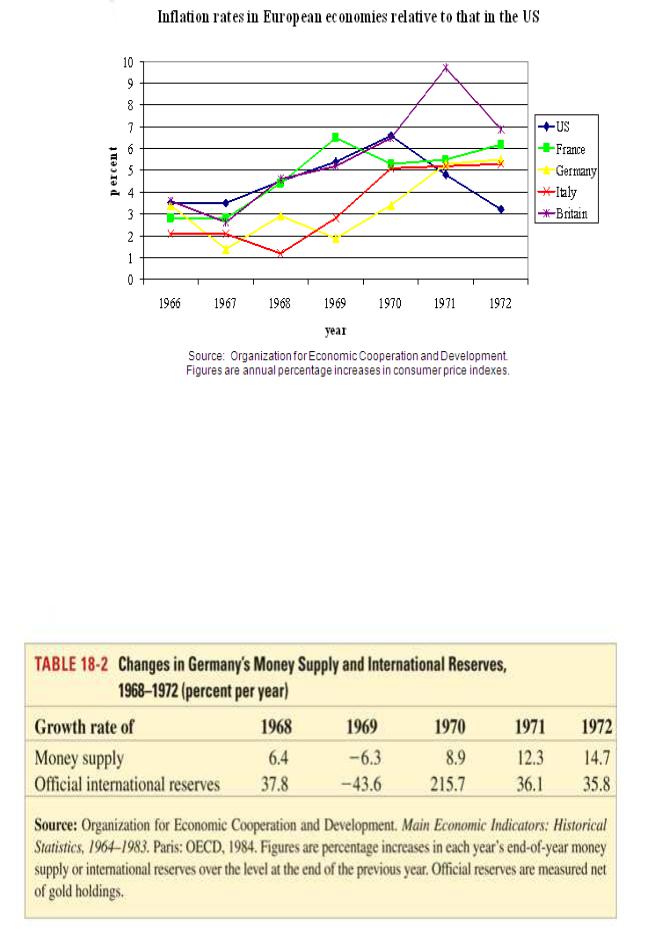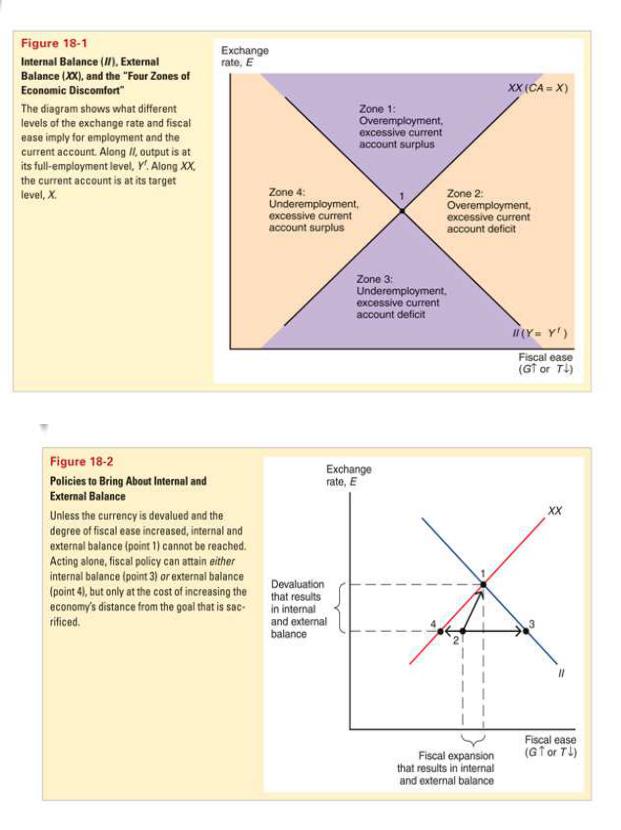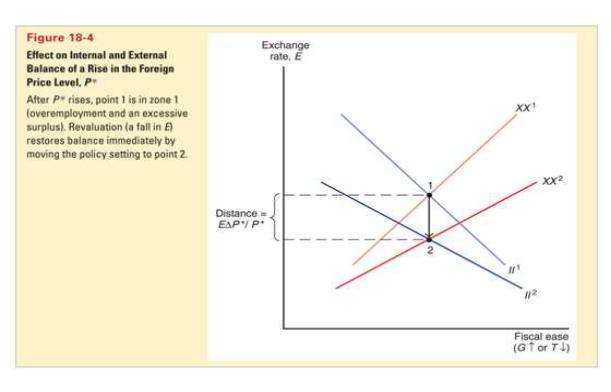
8855
.pdfSupply of gold from new discoveries was growing slowly.
Holding dollar denominated assets was the alternative.
•At some point, dollar denominated assets held by foreign central banks would be greater than the amount of gold held by the Federal Reserve.
•The US would eventually not have enough gold: foreigners would lose confidence in the ability of the Federal Reserve to maintain the fixed price of gold at $35/ounce, and therefore would rush to redeem their dollar assets before the gold ran out.
This problem is similar to what any central bank may face when it tries to maintain a fixed exchange rate.
If markets perceive that the central bank does not have enough official international reserve assets to maintain a fixed rate, a balance of payments crisis is inevitable.
Collapse of the Bretton Woods System
•The US was not willing to reduce government purchases or increase taxes significantly, nor reduce money supply growth.
•These policies would have reduced output and inflation, and increased unemployment.
The US could have attained some semblance of external balance at a cost of a slower economy.
•A devaluation, however, could have avoided the costs of low output and high unemployment and still attain external balance (increased current account and official international reserves).
•The imbalances of the US, in turn, caused speculation about the value of the US dollar, which caused imbalances for other countries and made the system of fixed exchange rates harder to maintain.
Financial markets had the perception that the US economy was experiencing a “fundamental equilibrium” and that a devaluation would be necessary.
11
•First, speculation about a devaluation of the dollar caused markets to buy large quantities of gold.
The Federal Reserve sold huge quantities of gold in March 1968, but closed markets afterwards.
Thereafter, private investors were no longer allowed to redeem gold from the Federal Reserve or other central banks.
The Federal Reserve would sell only to other central banks at $35/ounce. But even this arrangement did not hold: the US devalued its dollar in terms of gold in December 1971 to $38/ounce.
•Second, speculation about a devaluation of the dollar in terms of other currencies caused markets to buy large quantities of foreign currency assets.
A coordinated devaluation of the dollar against foreign currencies of about 8% occurred in December 1971.
Speculation about another devaluation occurred: European central banks sold huge quantities of European currencies in early February 1973, but closed markets afterwards.
Central banks in Japan and Europe stopped selling their currencies and stopped purchasing of dollars in March 1973, and allowed demand and supply of currencies to push the value of the dollar downward.
International Effects of US Macroeconomic Policies
•Recall from chapter 17, that the monetary policy of the country which owns the reserve currency is able to influence other economies in a reserve currency system.
•In fact, the acceleration of inflation that occurred in the US in the late 1960s also occurred internationally during that period.
12

•Evidence shows that money supply growth rates in other countries even exceeded the rate in the US.
•This could be due to the effect of speculation in the foreign exchange markets.
Central banks were forced to buy large quantities of dollars to maintain fixed exchange rates, which increased their money supplies at a more rapid rate than occurred in the US.
13
Summary
1.Internal balance means that an economy enjoys normal output and employment and price stability.
2.External balance roughly means a constant level of official international reserves or a current account that is not too positive or too negative.
3.The gold standard had two mechanism that helped to prevent external imbalances
Price specie flow mechanism: the automatic adjustment of prices as gold flows into or out of a country.
Rules of the game: buying or selling of domestic assets by central banks to influence financial capital flows.
4.The Bretton Woods agreement in 1944 established fixed exchange rates, using the US dollar as the reserve currency.
5.The IMF was also established to provide countries with financing for balance of payments deficits and to judge if changes in fixed rates were necessary.
6.Under the Bretton Woods system, fiscal policies were used to achieve internal and external balance, but they could not do both simultaneously, often leading to external imbalances.
7.The Bretton Woods agreement in 1944 established fixed exchange rates, using the US dollar as the reserve currency.
8.The IMF was also established to provide countries with financing for balance of payments deficits and to judge if changes in fixed rates were necessary.
9.Under the Bretton Woods system, fiscal policies were used to achieve internal and external balance, but they could not do both simultaneously, often leading to external imbalances.
14

15

Chapter 19
Macroeconomic Policy and Coordination Under Floating Exchange Rates
Preview
•Arguments for flexible exchange rates
•Arguments against flexible exchange rates
•Foreign exchange markets since 1973
•Interdependence of large countries
•The Chaing Mai Initiative for East Asian countries
Introduction
•The Bretton Woods system collapsed in 1973 because central banks were unwilling to continue to buy over-valued dollar assets and to sell under-valued foreign currency assets.
•Central banks thought they would stop trading in the foreign exchange for a while, and would let exchange rates adjust to supply and demand, and then would re-impose fixed exchange rates soon.
•But no new global system of fixed rates was started again.
16
Arguments for Flexible Exchange Rates
1.Monetary policy autonomy
Without a need to trade currency in foreign exchange markets, central banks are more free to influence the domestic money supply, interest rates and inflation.
Central banks can more freely react to changes in aggregate demand, output and prices in order to achieve internal balance.
2.Automatic stabilization
Flexible exchange rates change the prices of a country’s products and help reduce “fundamental disequilibria”.
One fundamental disequilibrium is caused by an excessive increase in money supply and government purchases, leading to inflation, as we saw in the US during 1965–1972.
Inflation means that the currency’s purchasing power falls, both domestically and internationally, and flexible exchange rates can automatically adjust to account for this fall in value, as PPP predicts should happen.
Another fundamental disequilibrium could be caused by a general shift in aggregate demand for a country’s products.
Flexible exchange rates would automatically adjust to stabilize high or low aggregate demand and output, thereby keeping output closer to its normal level and also stabilizing price changes in the long run.
In the long run, a real depreciation of domestic products occurs as prices fall (due to low aggregate demand, output and employment) under fixed exchange rates.
In the short run and long run, a real depreciation of domestic products occurs through a nominal depreciation under flexible exchange rates.
17

•Fixed exchange rates can not survive for long in a world with divergent macroeconomic policies and other changes which affect national aggregate demand and national output differently.
•Flexible exchange rates may also prevent speculation in some cases.
•Fixed exchange rates are unsustainable if markets believe that the central bank does not have enough official international reserves.
Arguments Against Bretton Woods System
4.Symmetry (not possible under Bretton Woods)
The US is now allowed to adjust its exchange rate, like other countries.
Other countries are allowed to adjust their money supplies for macroeconomic goals, like the US.
Arguments Against Flexible Exchange Rates
1.Uncoordinated macroeconomic policies
Flexible exchange rates lose the coordination of monetary polices through fixed exchange rates.
18
Lack of coordination may cause “ expenditure switching” policies: each country may want to maintain a low valued currency, so that aggregate demand is switched to domestic output at the expense of other economies
•In contrast, “expenditure changing” fiscal policies are thought to change the level of aggregate demand in the short run for both domestic and foreign products.
Lack of coordination may cause volatility in national economies: because a large country’s fiscal and monetary policies affect other economies; aggregate demand, output and prices become more volatile across countries as policies diverge.
•Volatile aggregate demand and output, especially in export sectors and import-competing sectors, leads to volatile employment.
•Volatility, not stabilization, may occur.
2.Speculation and volatility in the foreign exchange market become worse, not better.
If traders expect a currency to depreciate in the short run, they may quickly sell the currency to make a profit, even if it is not expected to depreciate in the long run.
Expectations of depreciation lead to actual depreciation in the short run.
Earlier we assumed that expectations do not change under temporary shocks to the economy, but this assumption is not valid if expectations change quickly in anticipation of even temporary economic changes.
Such speculation tends to increase the fluctuations of exchange rates around their long run values, as currency traders quickly react to changing (interpretations of) economic news.
In fact, volatility of exchange rates since 1973 has become larger.
But how big of a problem is this?
3.Reduction of trade and international investment caused by uncertainty about exchange rates.
19
But precisely because of a desire to reduce this uncertainty, forward exchange rates and derivative assets were created to insure against exchange rate volatility.
And international investment and trade have expanded since the Bretton Woods system was abandoned.
And controls on flows of financial capital are often necessary under fixed exchange rate systems, in order to prevent capital flight and financial market speculation.
4.Discipline: if central banks are tempted to enact inflationary monetary policies,
adherence to a fixed exchange rates may force them not to print so
much money.
But the temptation may not go away: devaluation due to inflationary monetary policy may still be necessary.
And inflation is contained in the country that creates it under flexible exchange rates: the US could no longer “export” inf lation after 1973.
And inflation targets may be better discipline than exchange rate targets.
5.Illusion of greater monetary policy autonomy
Central banks still need to intervene in the foreign exchange market because the exchange rate, like inflation, affects the economy a great deal.
But for the US, exchange rate stability is usually considered less important by the Federal Reserve than price stability and output stability.
Since 1973
•In 1975, IMF members met in Rambouillet, France to allow flexible exchange rates, but to prevent “erratic fluctuations”.
•In 1976 in Kingston, Jamaica, they amended the articles of agreement for IMF membership to formally endorse flexible rates,
but prevented members from “manipulating exchange r ates…to gain an unfair competitive advantage”, i.e., no expenditure switching policies
were allowed.
20
